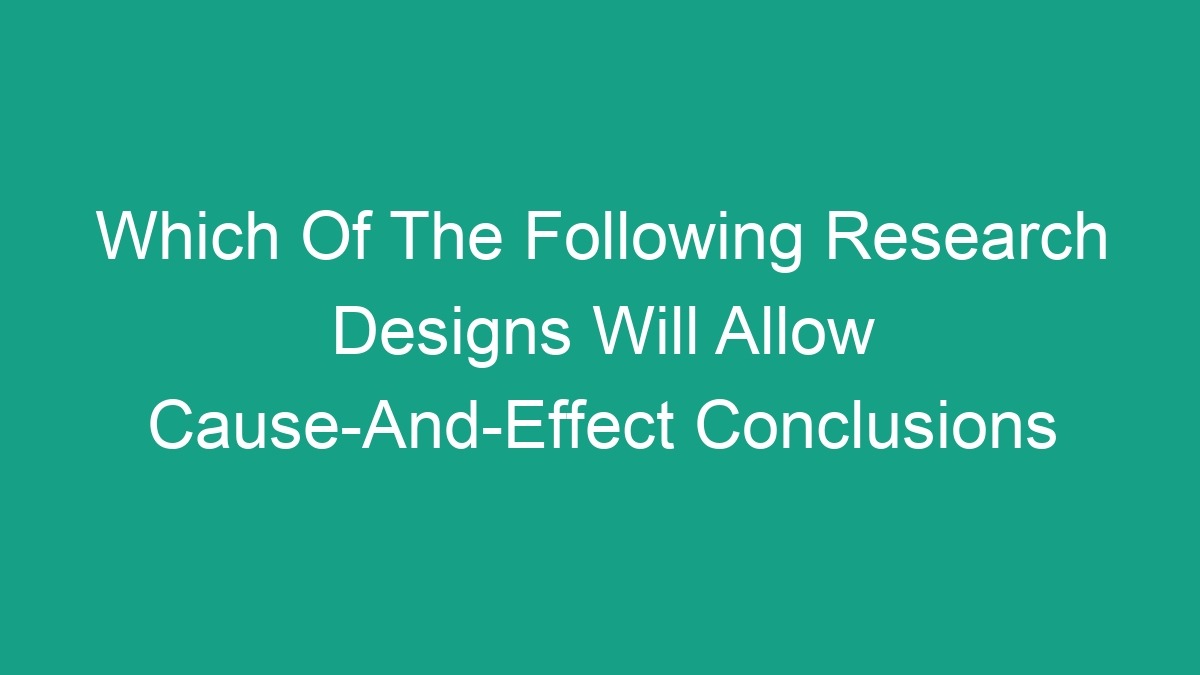
When it comes to conducting research, one of the most important goals is to establish cause-and-effect relationships between variables. However, not all research designs are capable of producing such conclusions. In this article, we will explore the various research designs and identify which ones allow for cause-and-effect conclusions.
The Importance of Cause-and-Effect Conclusions
Before delving into the specific research designs, it’s crucial to understand why cause-and-effect conclusions are so important in the field of research. Establishing a cause-and-effect relationship between variables allows researchers to make predictions and understand the underlying mechanisms of a phenomenon.
For example, if a researcher is interested in determining whether a new drug causes a reduction in symptoms of a particular disease, establishing a cause-and-effect relationship is essential. Without this, it would be challenging to make confident claims about the efficacy of the drug.
Experimental Research Design
Experimental research design is widely considered the gold standard for establishing cause-and-effect relationships. In an experimental design, the researcher manipulates one or more independent variables and measures the effect on dependent variables while controlling for extraneous variables.
The key features of experimental research design that allow for cause-and-effect conclusions are manipulation and control. By manipulating the independent variable and controlling for extraneous variables, researchers can confidently establish a causal relationship between the variables.
For example, in a clinical trial testing the effectiveness of a new medication, participants are randomly assigned to either the medication group or a placebo group. The researcher then measures the difference in outcomes between the two groups, allowing them to conclude whether the medication has a causal effect on the outcomes.
Quasi-Experimental Research Design
While experimental research design is the ideal method for establishing cause-and-effect relationships, there are situations where it may not be feasible or ethical to conduct an experiment. In such cases, researchers may turn to quasi-experimental research design.
Quasi-experimental research design shares similarities with experimental design in that it involves the manipulation of an independent variable. However, unlike true experimental design, participants are not randomly assigned to different conditions.
Despite the lack of random assignment, quasi-experimental research can still allow for cause-and-effect conclusions under certain conditions, such as when the researchers use statistical techniques to control for potential confounding variables. While not as strong as true experimental design, quasi-experimental research can still provide valuable insights into causal relationships.
Longitudinal Research Design
Longitudinal research design involves collecting data from the same subjects over a prolonged period. This design allows researchers to examine changes in variables over time and can be useful for establishing cause-and-effect relationships.
By measuring the same variables at multiple time points, researchers can assess how changes in one variable predict changes in another variable. For example, in a study on the effects of exercise on cardiovascular health, a longitudinal design could track participants’ exercise habits and cardiovascular health over several years, allowing for conclusions about the causal relationship between exercise and cardiovascular health.
Correlational Research Design
Correlational research design involves the measurement of two or more variables to assess the degree of relationship between them. While correlation does not imply causation, it can provide valuable insights into potential cause-and-effect relationships.
In some cases, correlational research can be a precursor to experimental research, helping researchers identify variables that may be worth investigating further. However, it’s important to note that correlational research alone cannot establish cause-and-effect relationships. Instead, it provides a starting point for further investigation.
Cross-Sectional Research Design
Cross-sectional research design involves collecting data at a single point in time, allowing researchers to compare different groups or conditions. While cross-sectional designs are valuable for descriptive and comparative purposes, they are not well-suited for establishing cause-and-effect relationships.
Without the ability to track changes in variables over time or manipulate variables, cross-sectional research is limited in its capacity to make causal claims. Instead, it is more useful for understanding the current state of variables and identifying potential associations.
Conclusion
In conclusion, while not all research designs allow for cause-and-effect conclusions, experimental research design is the most robust method for establishing causal relationships. Quasi-experimental, longitudinal, and correlational research designs can also provide valuable insights into causality under certain conditions, but they are not as powerful as experimental design.
Researchers should carefully consider the strengths and limitations of each research design when aiming to establish cause-and-effect relationships. By choosing the most appropriate design for their research question, they can ensure that their conclusions are reliable and impactful.



